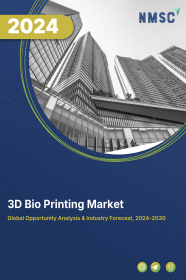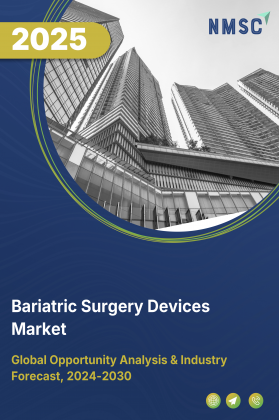
3D Bio Printing Market by Technology (Inkjet-based, Extrusion-based, Laser-assisted, Stereolithography (SLA), Selective laser sintering (SLS), Others), by Material (Bioinks, Hydrogels, Synthetic Polymers, Natural Polymers), by Application (Lifescience, Cell Culture, Regenerative Medicine, Medical Research, Others)- Global Opportunity Analysis and Industry Forecast 2022- 2030
Market Definition:
The 3D Bio Printing Market size was valued at USD 952 million in 2021 and is predicted to reach USD 4.10 billion by 2030 with a CAGR of 17.6% from 2022-2030. 3D Bioprinting is a method of preparing biomedical structures with the use of biological molecules, viable cells, and biomaterials.
It is a type of additive manufacturing, through which living structures are printed layer by layer so that they can mimic the behavior of living systems. The entire process of printing involves three stages, such as pre-bioprinting, bioprinting, and post-bioprinting. 3D bioprinting is widely used for developing organs that can be later used for the development of medical implants, R&D of drugs, and scaffolds.
Market Dynamics and Trends:
The demand for 3D bio printing is rising due to increase in number of cosmetic surgeries around the world. Also, factors such as rising demand for high-throughput 3D-bioprinted tissue models for research and drug discovery, along with growing demand for organ transplantation globally are expected to drive the market growth. Moreover, increasing public and private investments to support 3D bioprinting research activities, is expected to propel the growth of the market during the forecast period.
However, dearth of skilled professionals and regulatory constraints are the factors restraining the growth of market to some extent. On the other hand, increase in stem cell research and expansion of regenerative medicine industry, owing to their use in the treatment of various diseases related to heart, liver, and cartilage among other organs, are factors expected to create lucrative growth opportunities for the 3D bio printing market players in future.
Market Segmentations and Scope of the Study:
The 3D bio printing market size has been segmented based on material, technology, application, and geography. Based on the material, the industry is classified into ceramics, polymers, and composite. Based on the technology, the industry is classified into syringe, pneumatic extrusion, inkjet, laser, and others. Based on application, the market is bifurcated into tissue and organ regeneration, medical, dental, biosensors, bio-inks, 3D cell culture, and pharmaceutical. The geography breakdown and analysis of each of the aforesaid segments includes regions comprising of North America, Europe, Asia-Pacific, and ROW.
Geographical Analysis:
North America region is expected to continue holding the lion share of 3D bio printing market during the forecast period. This is attributed to factors such as highly developed healthcare infrastructure, technological advancements, growing elderly population, and increasing prevalence of chronic ailments.
However, Asia-Pacific region is expected to show a steady rise in the 3D bio printing market due to technological developments in pharmaceutical sector. Also, China and Japan accounted for the largest revenue share in this region due to rising investment by the governments in R&D activities, along with increasing incidences of COVID-19 cases as 3D bioprinting technology helps in manufacturing respirators and ventilators to overcome the shortage of these devices.
Competitive Landscape:
The market comprises of various players such as are CELLINK, Stratasys, 3D Systems, Inc., Inventia Life Sciences, Aspect Biosystems Ltd., Cyfuse Biomedical, regenHU, Poietis, Corning Incorporated, ROKIT HEALTHCARE, INC., Prellis Biologics, Materialise, Brinter, The Bio Convergence Company, UPM Biomedicals. These manufacturers are actively indulging in R&D initiatives, product & technology innovations, and industrial collaborations to enhance their product and increase their growth and geographical reach.
For instance, in January 2021, 3D Systems announced expansion of its regenerative and bioprinting solutions. This decision was taken by collaborating with United Therapeutics Corporation. They are aiming to enable novel laboratory testing methods to accelerate the development of new drug therapies while reducing the need for animal testing.
Also, in January 2020, GE Healthcare Life Sciences inaugurated an additive manufacturing facility and manufacturing footprints in Sweden. This new facility would be dedicated to integrating 3D-printed parts into the company’s production of bio manufacturing equipment.
Key Benefits:
-
The 3D bio printing market report provides the quantitative analysis of the current market and estimations through 2022-2030 that assists in identifying the prevailing market opportunities to capitalize on.
-
The study comprises a deep dive analysis of the 3D bio printing market trend including the current and future trends for depicting the prevalent investment pockets in the market.
-
The information related to key drivers, restraints and opportunities and their impact on the 3D bio printing market is provided in the report.
-
The competitive analysis of the market players along with their market share in the 3D bio printing market.
-
The SWOT analysis and Porters Five Forces model is elaborated in the study.
-
Value chain analysis in the market study provides a clear picture of the stakeholders’ roles.
Key Market Segments:
By Technology
-
Inkjet-based
-
Extrusion-based
-
Laser-assisted
-
Stereolithography (SLA)
-
Selective laser sintering (SLS)
-
Others
By Material
-
Bioinks
-
Hydrogels
-
Synthetic Polymers
-
Natural Polymers
By Application
-
Lifescience
-
Cell Culture
-
Regenerative Medicine
-
Medical Research
-
Others
By Geography
-
North America
-
The U.S.
-
Canada
-
Mexico
-
-
Europe
-
The UK
-
Germany
-
France
-
Italy
-
Spain
-
Denmark
-
Netherlands
-
Finland
-
Sweden
-
Norway
-
Russia
-
Rest of Europe
-
-
Asia-Pacific
-
China
-
Japan
-
India
-
South Korea
-
Australia
-
Indonesia
-
Singapore
-
Taiwan
-
Thailand
-
Rest of Asia-Pacific
-
-
RoW
-
Latin America
-
Middle East
-
Africa
-
Key Players:
-
CELLINK
-
Stratasys
-
3D Systems, Inc.
-
Inventia Life Sciences
-
Aspect Biosystems Ltd.
-
Cyfuse Biomedical
-
regenHU
-
Poietis
-
Corning Incorporated
-
ROKIT HEALTHCARE, INC.
-
Prellis Biologics
-
Materialise
-
Brinter
-
The Bio Convergence Company
-
UPM Biomedicals
REPORT SCOPE AND SEGMENTATION:
|
Parameters |
Details |
|
Analysis Period |
2021–2030 |
|
Base Year Considered |
2021 |
|
Forecast Period |
2022–2030 |
|
Market Size Estimation |
Billion (USD) |
|
Market Segmentation |
By Material (Ceramics, Polymers, and Composite), by Technology (Syringe, Pneumatic Extrusion, Inkjet, Laser, and Others), by Application (Tissue and Organ Regeneration, Medical, Dental, Biosensors, Bio-Inks, 3D Cell Culture, and Pharmaceutical) |
|
Geographical Segmentation |
North America (U.S., Canada, Mexico) Europe (UK, Germany, France, Italy, Spain, Rest of Europe), Asia-Pacific (China, India, Japan, South Korea, Australia, Rest of Asia-Pacific), Rest of the World (UAE, Saudi Arabia, South Africa, Brazil, Remaining countries) |
|
Companies Profiled |
Cyfuse Biomedical K.K., CELLINK, Organovo Holdings Inc., BioBots, Aspect Biosystems Ltd., Ourobotics, Aerotech Inc.,3D Bioprinting Solutions, GE Healthcare Life Sciences, Bio3D Technologies, Advanced Solutions Inc. |




















 Speak to Our Analyst
Speak to Our Analyst

























